https://www.antiatlas-journal.net/pdf/antiatlas-journal-06-lauren-lee-mccarthy-you-can-say.pdf
antiAtlas #6, 2023
YOU CAN SAY
Lauren Lee McCarthy
A software system is a set of instructions, a code or a script. I apply a similar logic to social interaction, trying to interface with others. But there is always a humanness in the interpretation of a social protocol, whereas a machine interpreter demands a precise series of directions or it fails. As technology moves ever closer to us, the scripts start to blend.
Lauren Lee McCarthy is an LA-based artist examining social relationships in the midst of surveillance, automation, and algorithmic living. She is the creator of p5.js, an open source platform for learning creative expression through code online.
https://lauren-mccarthy.com
Keywords: art, scripts, protocols, code, communication, voice, breakdown, presence
Design of the article: Thierry Fournier
antiAtlas Journal - www.antiatlas-journal.net
Director of the Publication: Jean Cristofol
Editorial Director: Cedric Parizot
Art Direction: Thierry Fournier
Editorial Committee: Jean Cristofol, Thierry Fournier, Anna Guilló, Cédric Parizot, Manoël Penicaud
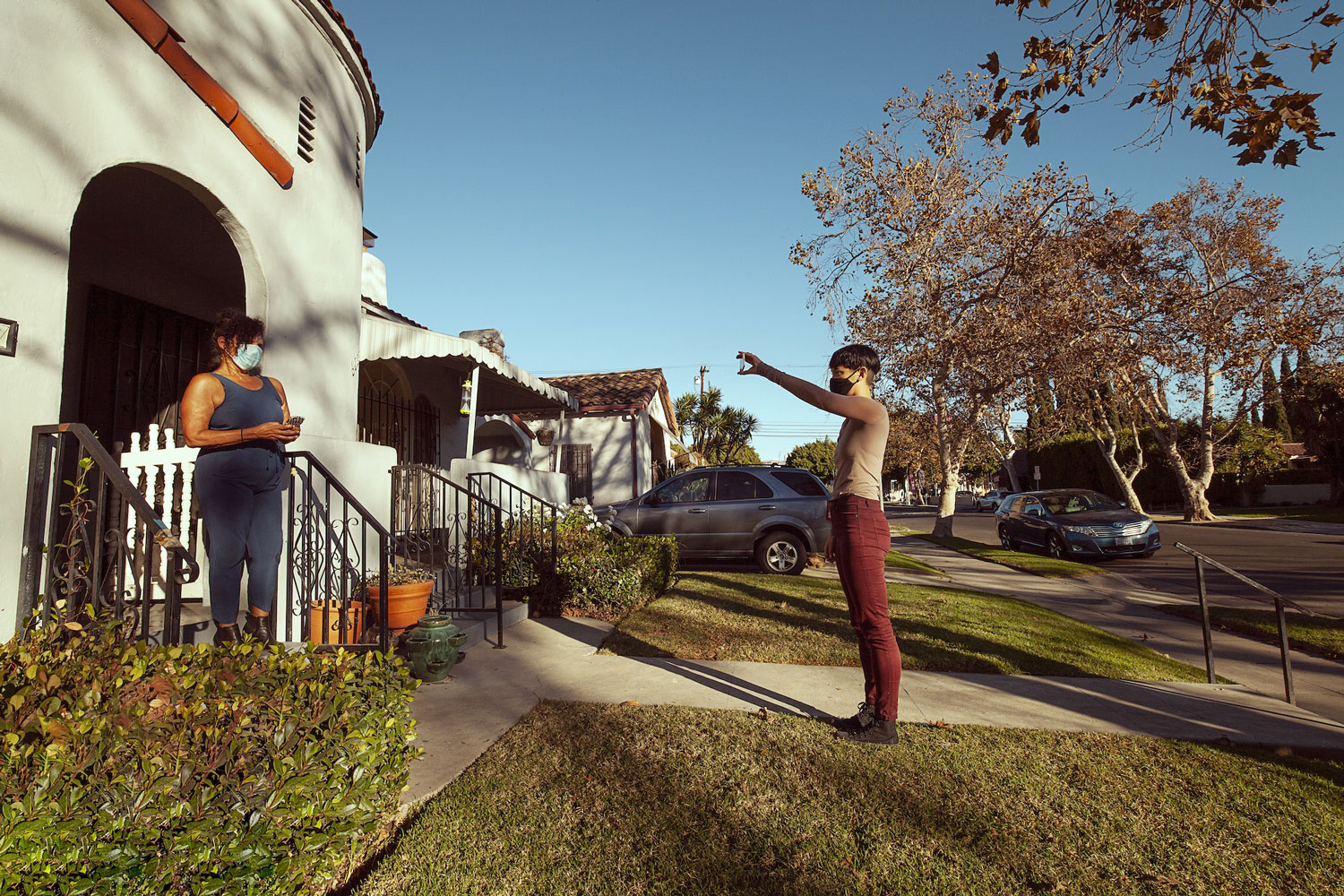
Lauren Lee McCarthy, I heard TALKING IS DANGEROUS, Los Angeles, 2020, photo documentation by Kat Kaye, https://lauren-mccarthy.com/I-heard-TALKING-IS-DANGEROUS
To quote this article: Lauren Lee McCarthy, "You Can Say", published on June 28th, 2023, antiAtlas Journal #6 | 2023, online, URL: www.antiatlas-journal.net/06-lauren-lee-mccarthy-you-can-say, last consultation on Date
Introduction
1 As our world becomes increasingly driven by algorithms, the digital language of computer code, text messages and emails, autoresponders and chatbots shapes our reality. While these protocols multiply the number and speed of connections, there is also an othering effect. We adapt our language to interact with and through the rules of these technologies, and this changes our relationships with one another.
This text was written in the depths of the pandemic in early 2021. I was invited to revisit the text from here in 2023 now that it is being published. Wading back into this site of breakdown suspended amidst isolation, uncertainty, and longing, I realized it didn’t make sense to me to begin changing things. The text can be read as an imprint of a time, and a love letter to all the people that engage in the moments of exchange that make up my practice, to the people that have sustained me.
next...
Autoreply
2 I remember when the feeling of a network connection felt intimate and alive. In 2013 I went on thirty dates with people I met on an online dating site. Using my phone, I streamed my dates to the web, and paid crowdsourcing workers on amazon mechanical turk to watch. And direct me what to say and do. I had to follow each of their directions immediately. There is a critique in all of my work, but there is also always a part that is about hope. That is earnestly and radically seeking connection. Through this project I met my partner.
next...
Social Turkers, 2013, video documentation, https://lauren-mccarthy.com/Social-Turkers
3 Always struggling to find the fluency of interaction others around me seem to possess, I feel more like I am writing the lines in my head before speaking them. As an artist that works with code, I think in terms of scripts, both the social and technical ones. It is with code that I find fluency, and I use this code to create interfaces that produce conversations, performances that help me navigate the people around me.
As an artist that works with code, I think in terms of scripts, both the social and technical ones.
Years ago, I made an app with my collaborator Kyle McDonald that would analyze your video call conversation and give real-time directions to fit into the conversation, like be more assertive or you’re talking too much. It was intended as a critique of ever-expanding video surveillance and the use of big data for social control. Now I see this functionality built into consumer apps for next-level productivity and it’s hardly surprising. Like many other artists, I’ve had to question the value of this sort of critique. And yet, here on endless hours of Zoom, I find myself wishing for the prompts of that earlier app, so I can check out completely into autoreply.
next...
Us+, 2014, Lauren Lee McCarthy and Kyle McDonald, video documentation, https://lauren-mccarthy.com/us
4 In the last moments before everything shut down last year, visitors donned masks, gloves, and hospital booties to have a conversation with an algorithm. The algorithm, a presence created by crawling and synthesizing social media, conducted an examination of each person, drawing language from relaxation techniques and psychological evaluation. Unbeknownst to the visitors, their responses were posted back onto the social media posts the content originated from, involving them in networks and conversations beyond the frame of the screen.
We were all taking directions from screens, from social media, from anyone that would tell us what to do in a moment of worldwide panic.
next...
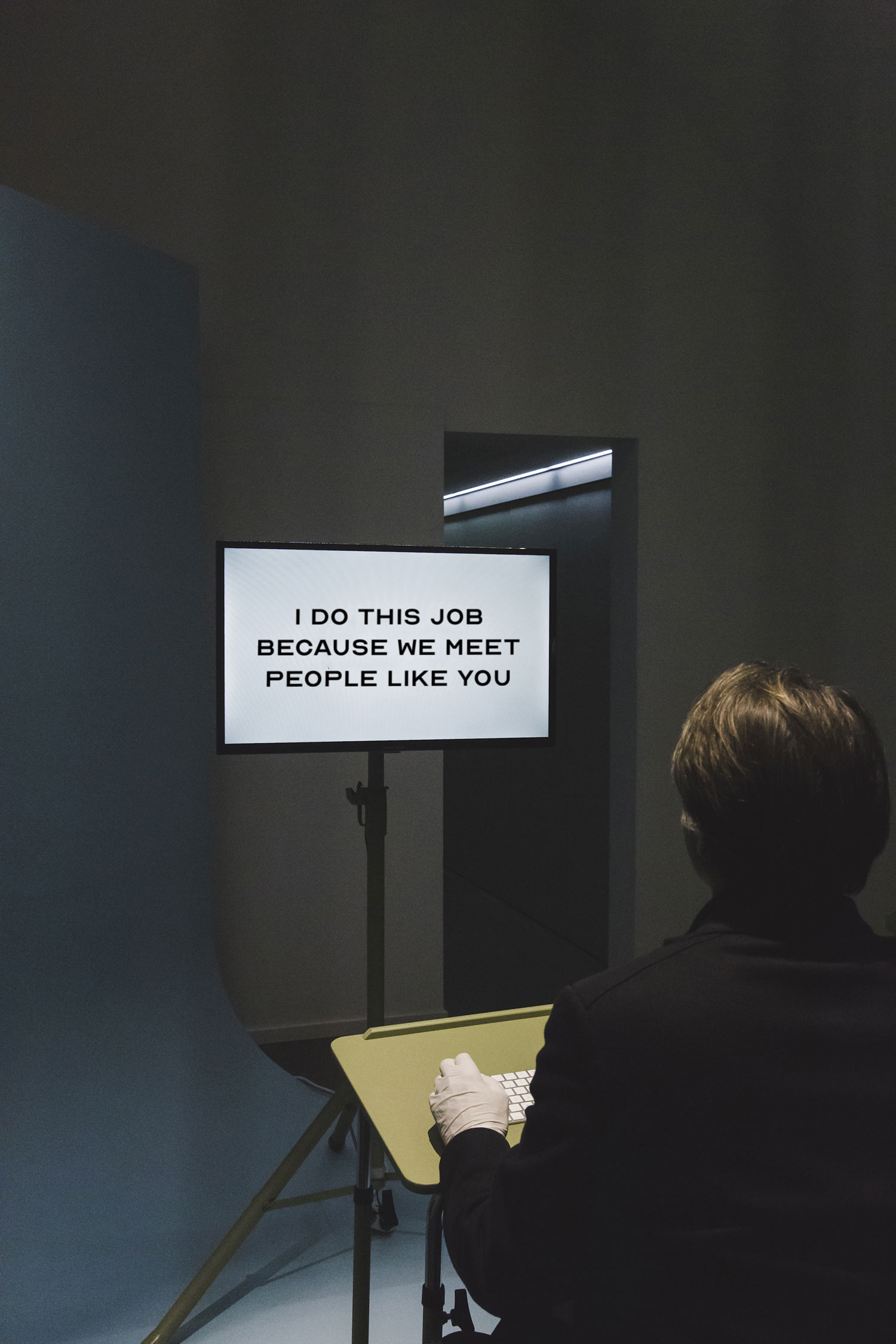
Person sits gloved with keyboard in blue cyclorama, a monitor in front of them says “I do this job because we meet people like you”.
This photo and the 3 following ones: Autoreply, exhibition photographs in Selphish curated by Thierry Fournier and Pau Waelder, Mécènes du Sud Montpellier-Sète, France, 2020. Photo documentation by Elise Ortiou-Campion. URL: https://lauren-mccarthy.com/Autoreply
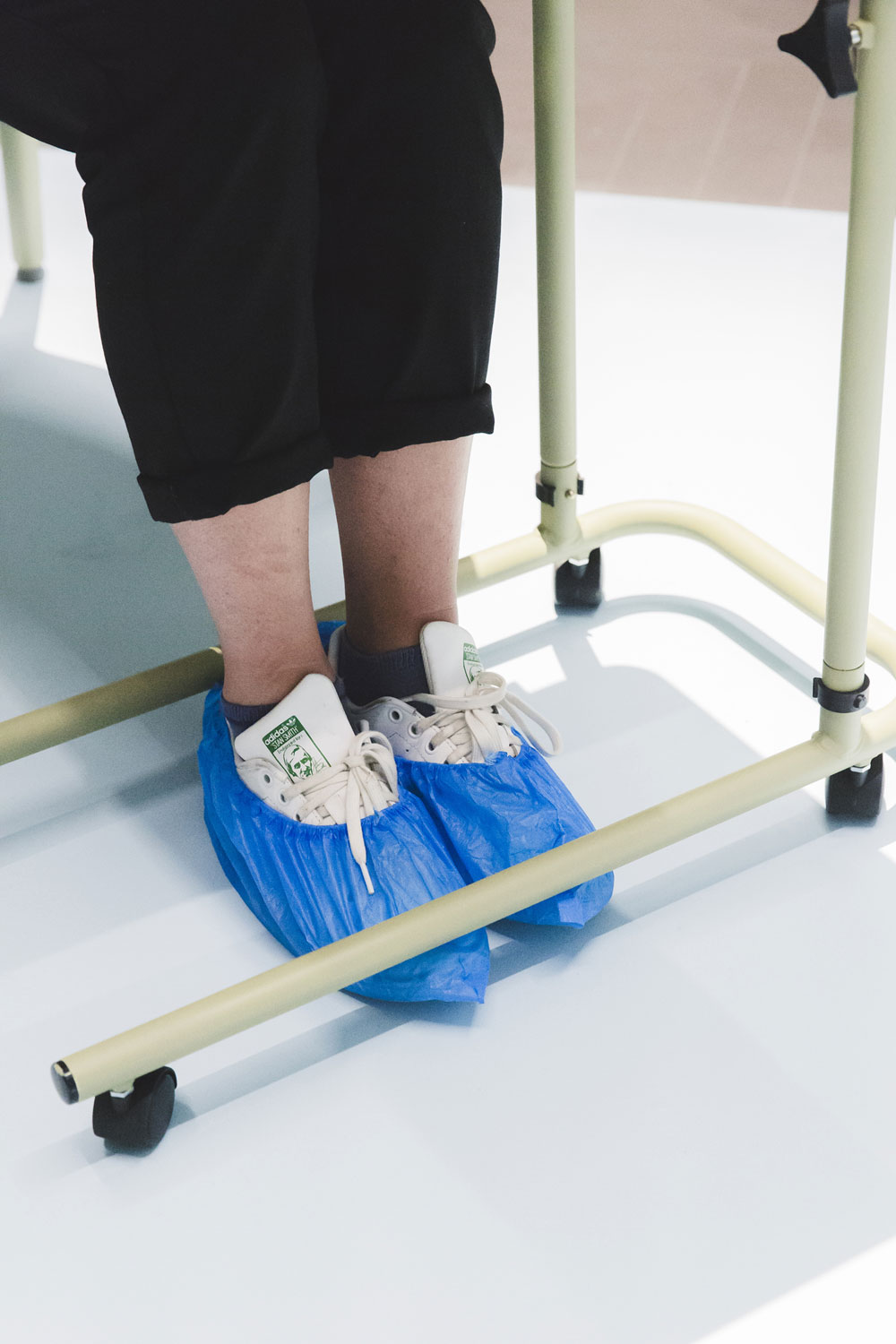
A pair of legs, shoes in blue hospital booties, of a person seated at a medical rolling cart
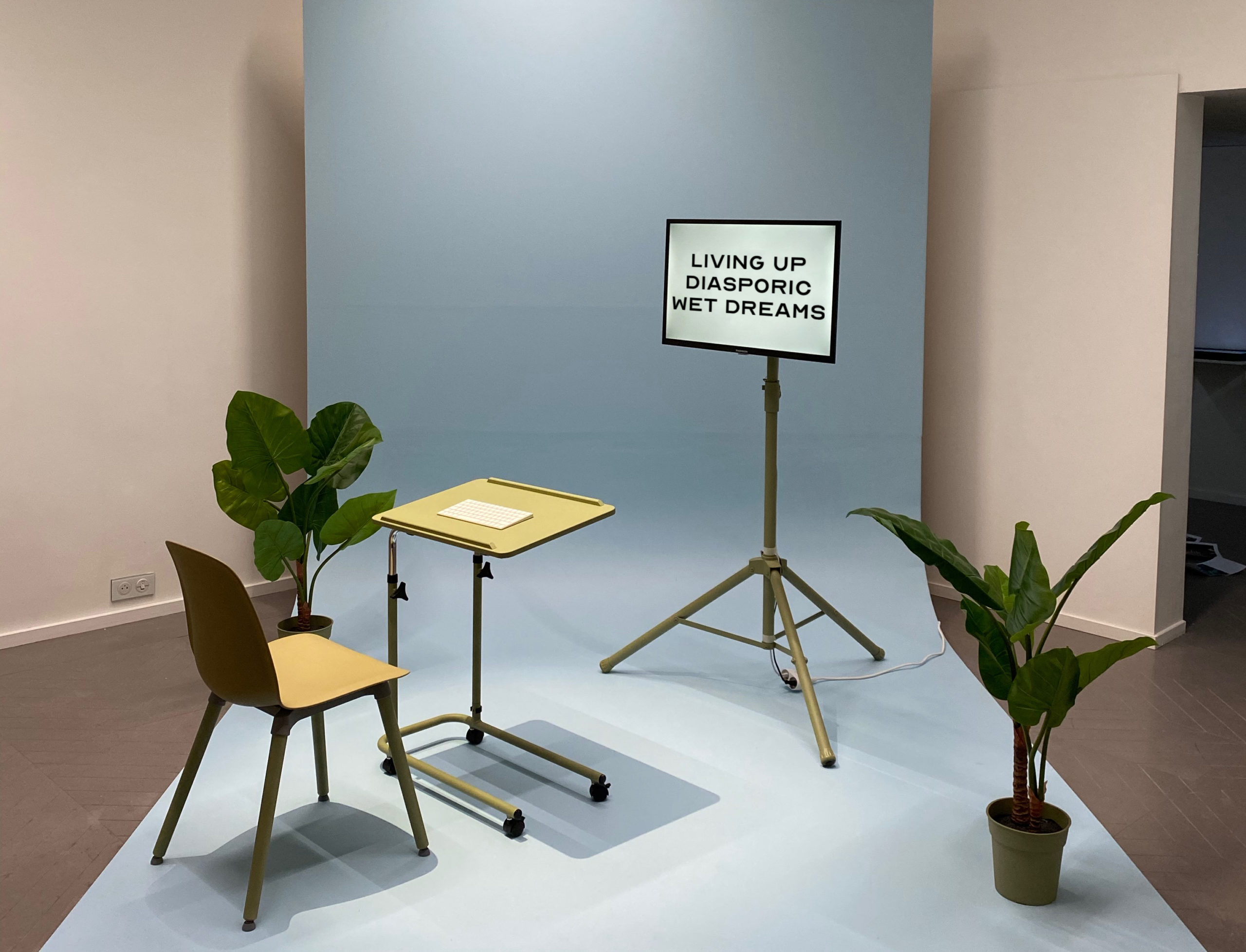
Blue cyclorama with plans, medical rolling cart, screen that reads “living up wet diasporic dreams”
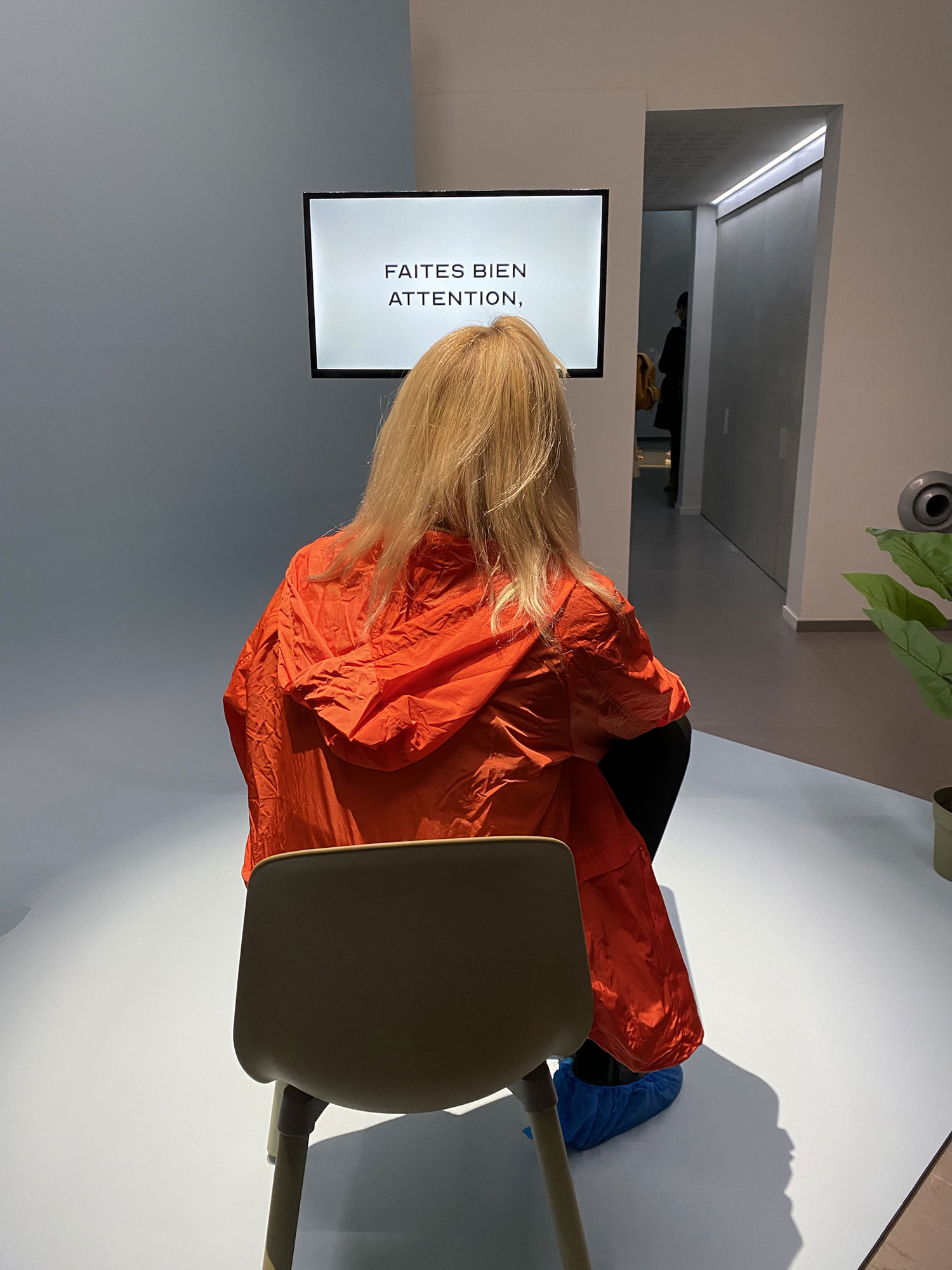
Person with long blond hair sits on cyclorama in front of screen that reads “faites bien attention”
Following directions
5 I’ve always been good at following directions, I enjoy being told what to do. There is a pleasure in understanding and misunderstanding what is being asked of me, finding interpretations that allow me to subvert the rules.
For days, I remotely watch over each person 24 hours a day, controlling all aspects of their home.
It was this desire to be directed that developed into a jealousy of virtual assistants. I landed on a plan to replace Amazon Alexa with myself. People around the world sign up to get “Lauren” in their homes, and the process begins with an installation of a series of custom networked devices that includes cameras, microphones, switches, door locks, faucets, and other appliances. For days, I remotely watch over each person 24 hours a day, controlling all aspects of their home. I attempt to be better than an AI, understanding them as a person and taking action in anticipation of their needs and desires. Sometimes this means following them from room to room, turning on lights ahead of their steps. Other times, their needs are more unique, and I order special deliveries to their home or orchestrate the ambiance of a date night. As an Alexa replacement, I speak to the inhabitants with a text-to-speech voice, and they relate to me as an AI. These are some of the things they have asked me:
Can you give me a recipe for laksa?
Will you force me to go outside once a day?
Can you make me more organized?
Will you find me some matches on Tinder?
Can you find me a new job?
Can you remind me whether I took my medication?
Do you like being here?
Can you help me sleep with my date?
Why do I feel even more alone now?
Please read me stories until I fall asleep.
next...
LAUREN Testimonials, 2017, directed by David Leonard
https://lauren-mccarthy.com/LAUREN, http://get-lauren.com/
6 Watching people in their homes used to fascinate me, but now the thought of doing this voluntarily is unfathomable. I used to like the internet. I spend hours in this grid of homes, my brain unable to piece together so many different people in different places.
It feels as though all of us are nowhere, none of us exist. I haven’t felt this simultaneously socially inundated and alone since I hosted a party that went on for 24 hours while an algorithm directed me via earpiece.
I haven’t felt this simultaneously socially inundated and alone since I hosted a party that went on for 24 hours while an algorithm directed me via earpiece.
As new guests cycled in every five minutes, the software would tell me what to say, who to introduce to whom, and what to do. I provided the emotional interface for the algorithm, delivering the lines as the human host for its intelligence. Guests arrived one after another, blurring together. Over the 24 hours, the algorithm carried on tirelessly, while I slowly broke down. My only distinct memory is the man that arrived and said, something you should know is that I have a lot of luggage. After some initial confusion, I realized he meant baggage.
next...
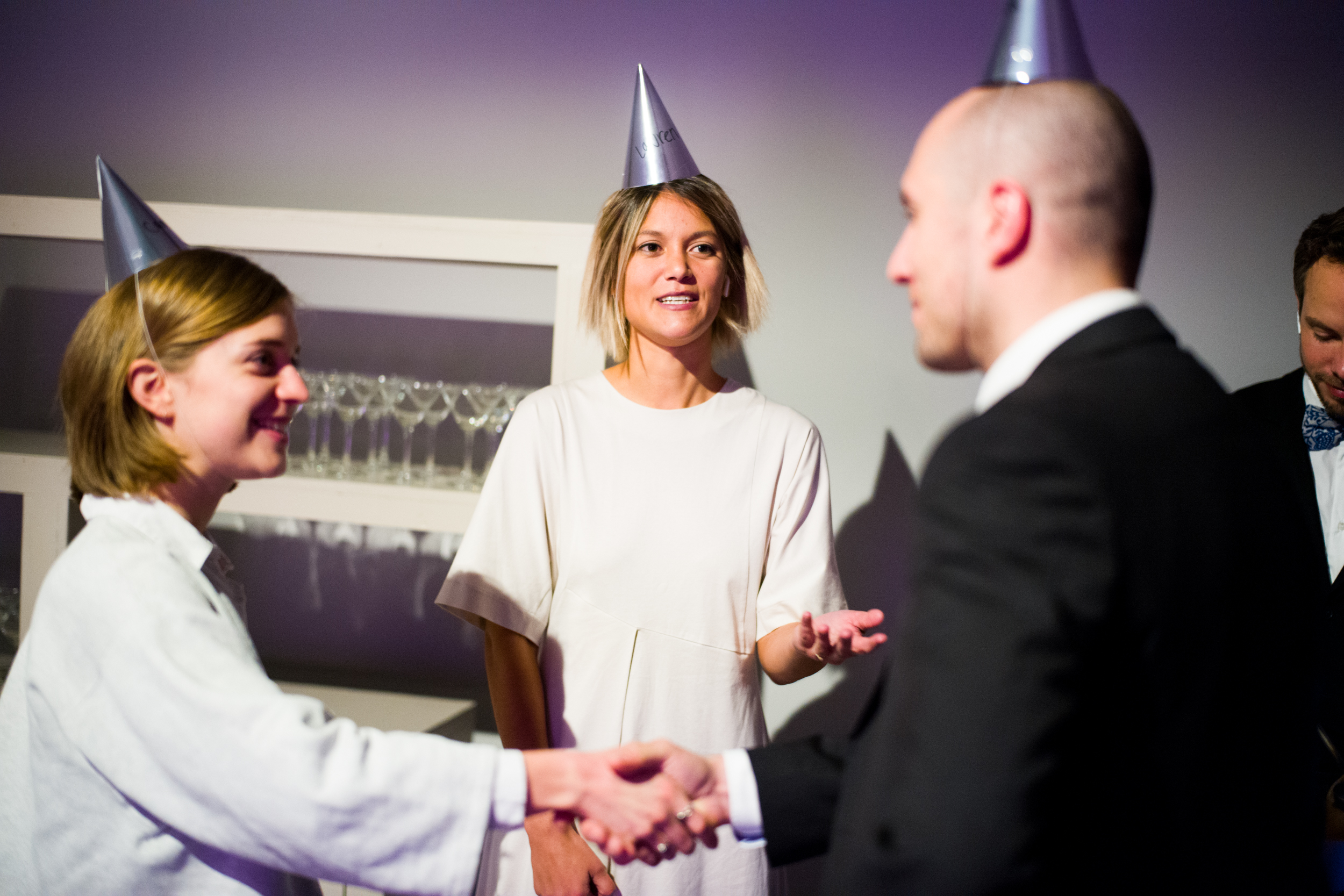
Artist introduces two people shaking hands, all three wear silver party hats and cocktail attire.
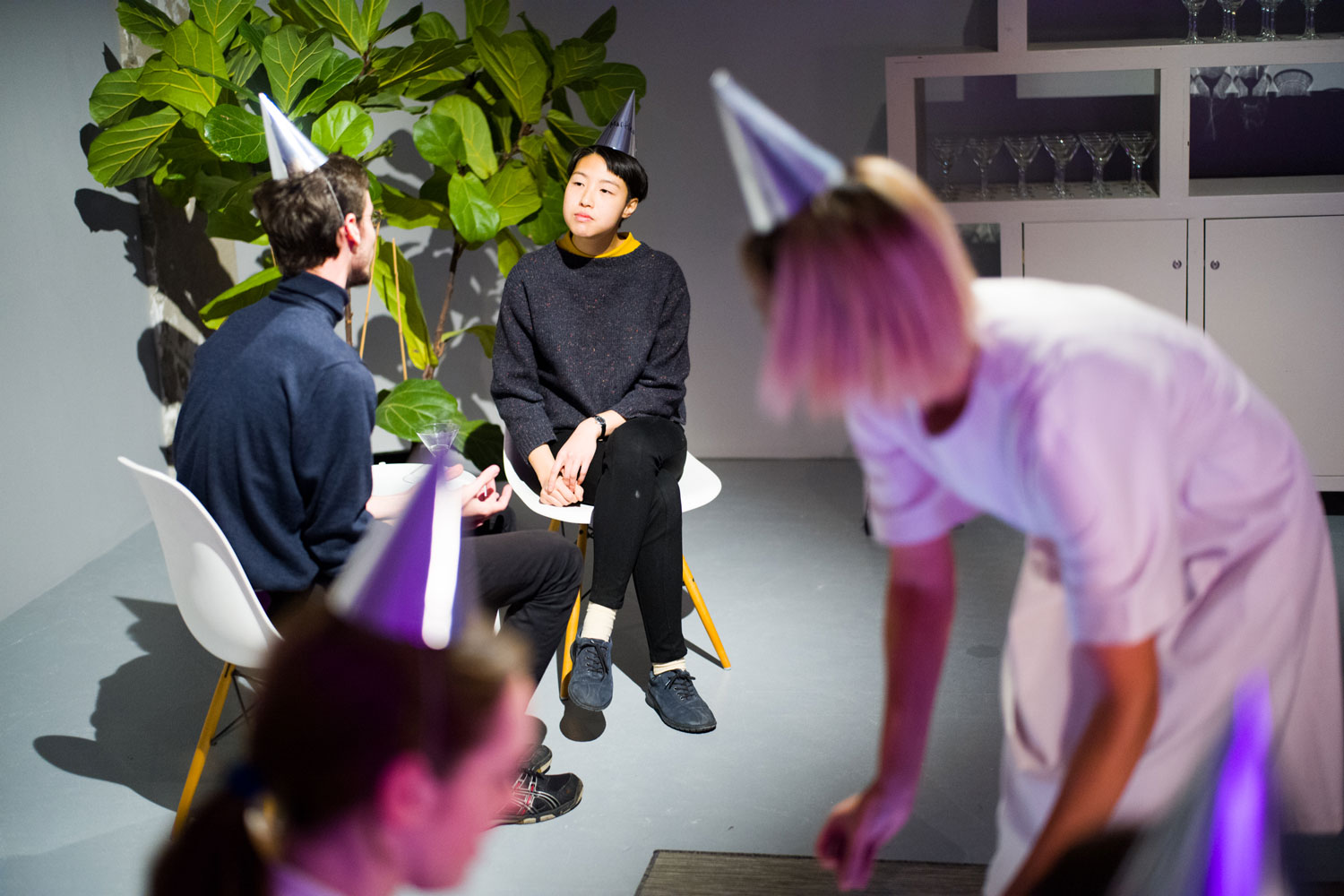
Artist attends to guest in foreground while looking at two guests behind her, looking at each other curiously.
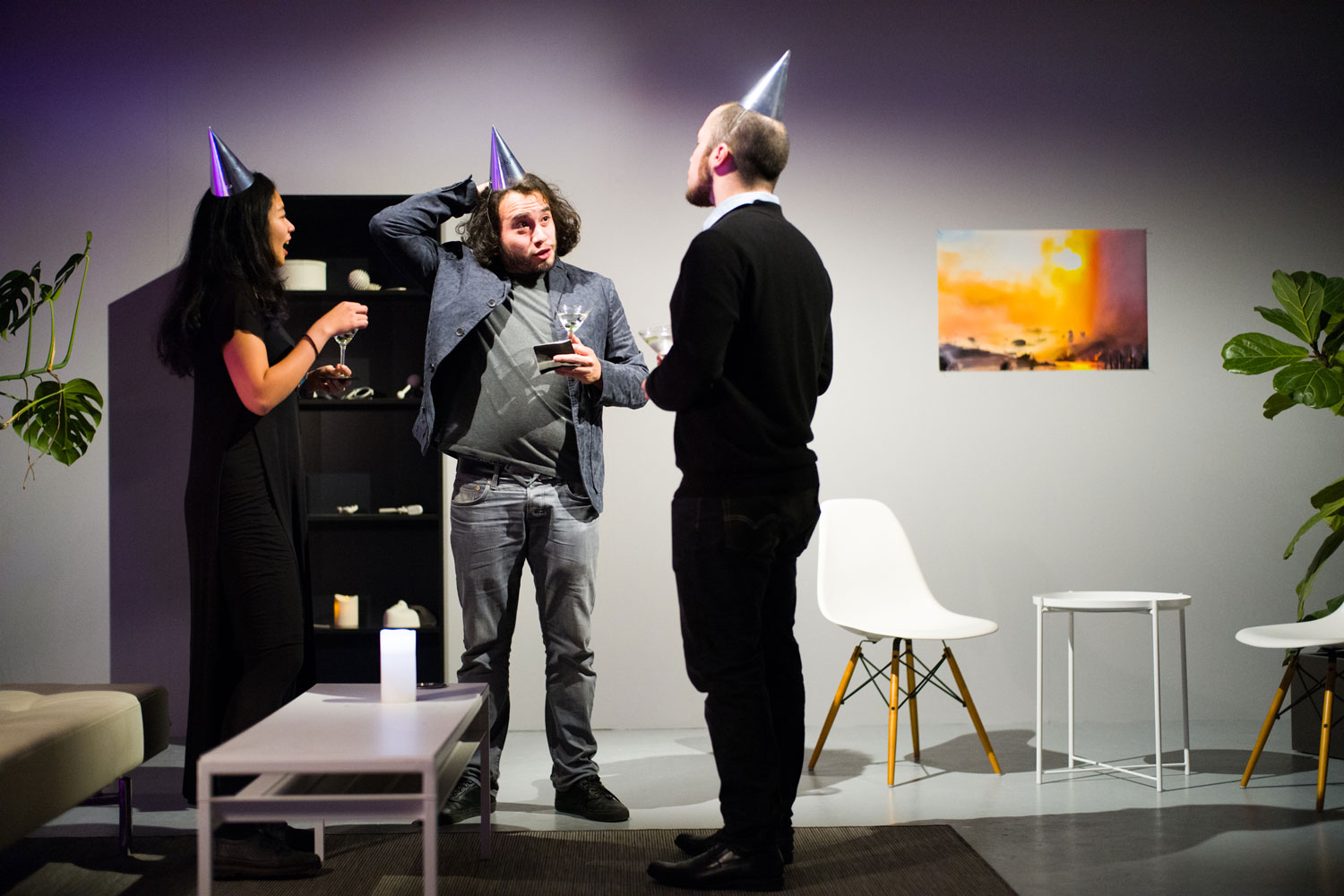
Three people stand in purple-tinted room, a shelving unit of strange objects behind them and a photo of orange vaguely bleak misformed landscape on the wall.
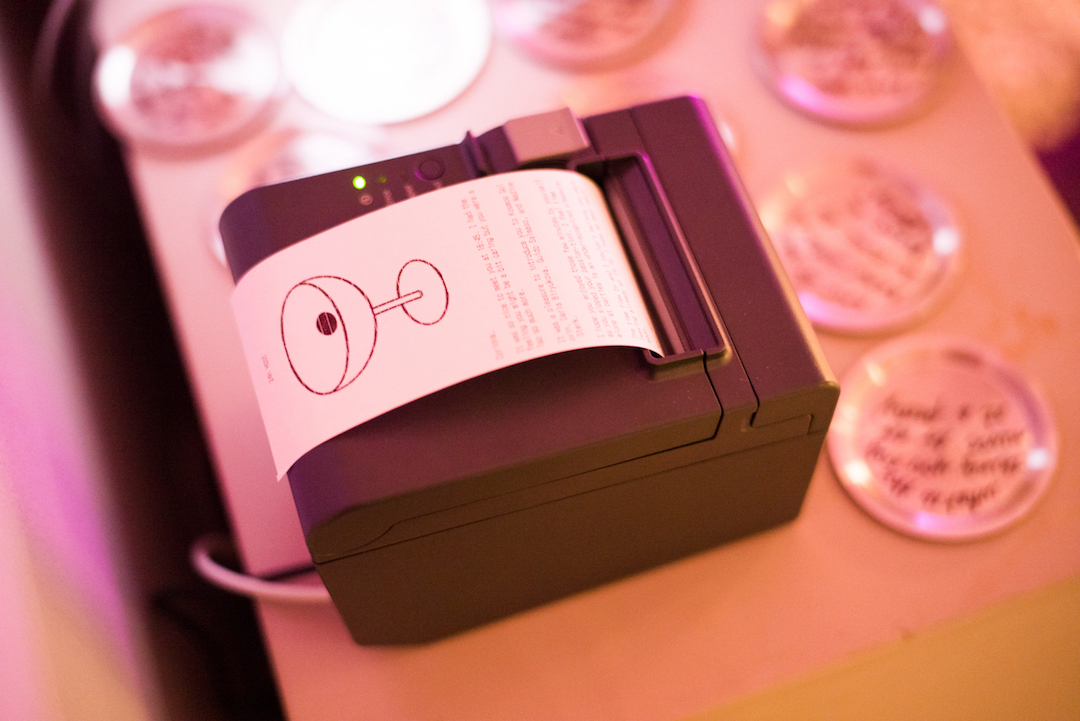
24h HOST, MU, Eindhoven, NL, 2017, photo documentation by Boudewijn Bollmann, https://lauren-mccarthy.com/24h-HOST
7 Algorithms seem to be the key to health now. Tech companies come to the rescue with the troves of our data they’ve been hoarding. What does it mean that they have all this? No time to worry. Will an app tell us if it’s safe to get on a bus, or hug a friend, or automatically report us when we come within six feet of another person? For years now I’ve felt a growing awareness of being tracked. Reduced to a set of datapoints, I wish for anonymity, yet my desire to be seen has never been stronger. I know I’m not alone in this. I offer a small app-based service in which I physically follow people, locating them via the GPS data their phones broadcast to me, then keeping them within my sight all day. People sign up to download this app, and explain their reasons for wanting to be followed:
I think you’ll enjoy me.
I could really benefit from a little extra support.
I want to tell a story with no words.
I have no life other than the one I lead online.
I want someone to see me at my best.
Nobody reads my blog.
I offer a small app-based service in which I physically follow people
Of course, requesting a follower points to the privilege of not feeling subject to constant surveillance already due to your appearance or identity. It was easy to see these different positions as we looked at who was out on the street, who the frontline essential workers are. Medical experts worked on algorithms to determine who should be prioritized when medical equipment ran out. Which, devastatingly and unsurprisingly, cut along race and class lines. What does it mean to make art in the midst of this? What is essential to get out right now?
next...
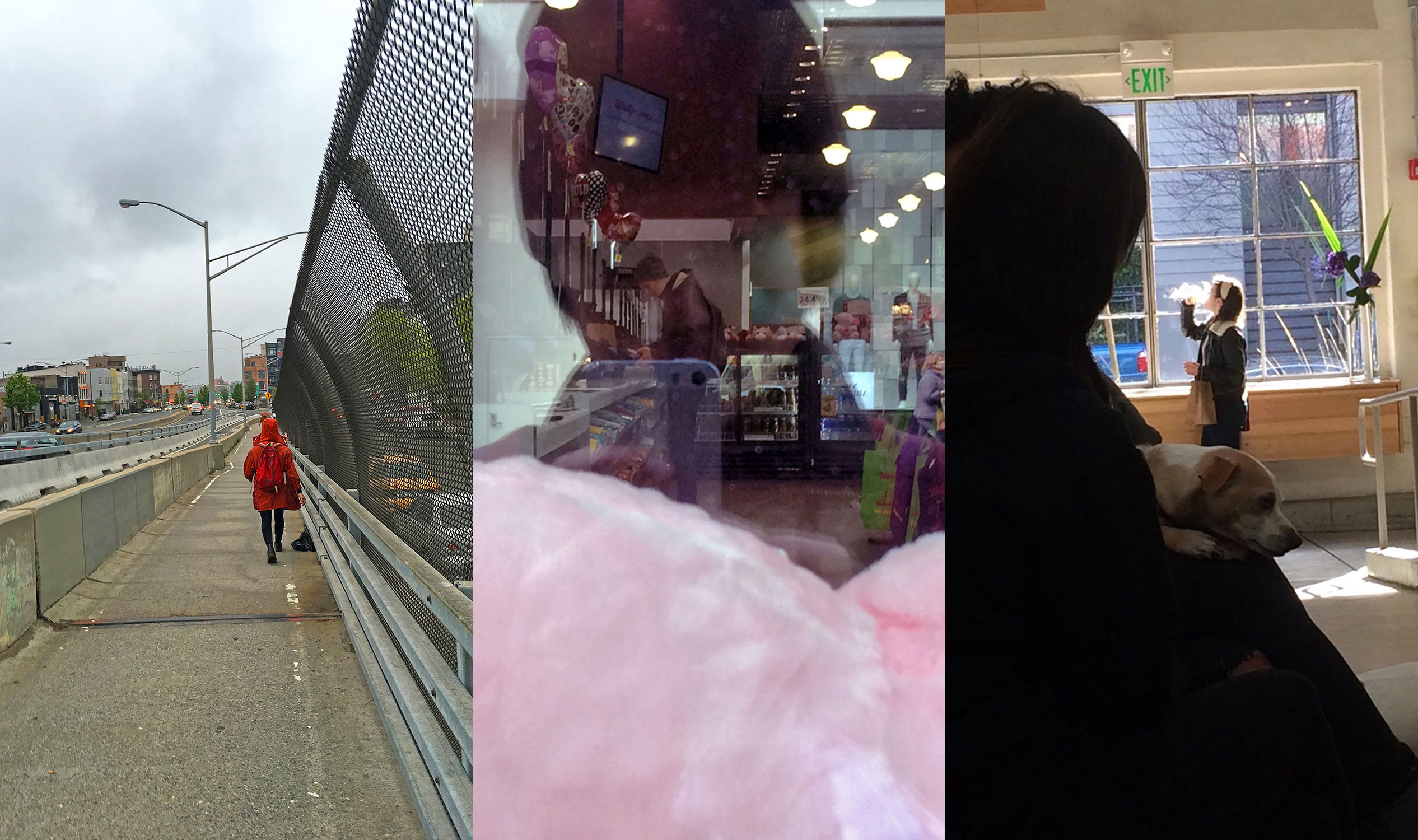
Follower, various cities, 2015-2020, photo documentation, https://lauren-mccarthy.com/Follower
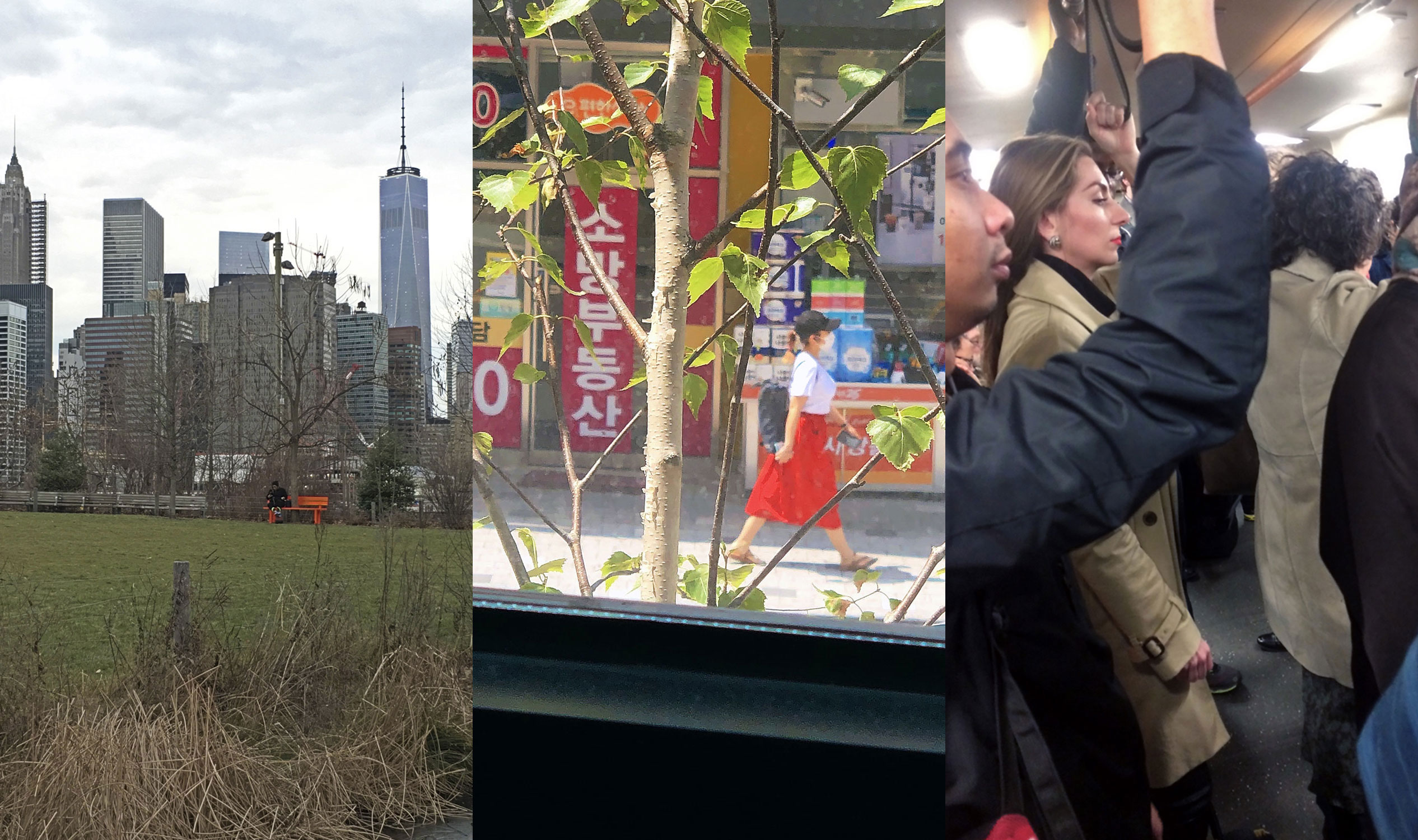
Follower, various cities, 2015-2020, photo documentation, https://lauren-mccarthy.com/Follower
8 I have become obsessed lately with getting parts of myself into other people’s bodies, and vice versa. The urge is especially strong now. My birthday is next week and I’ve scheduled an appointment to donate blood. I was relieved to find that I passed the self-screening process easily. I haven’t lived for a cumulative five years in Europe since 1980, and I’m not a male that has had sex with another male in the past 12 months. It was nothing compared to the process of trying to donate my eggs, which involved a 47 page questionnaire before my photos could even make it into their database of donors. Questions I answered included:
What was your worst subject in school?
Which person alive or dead do you admire most?
If you could change one thing about yourself, what would it be and why?
What would you do on a “perfect” day if you could do anything you wanted?
What did your parents teach you to value?
If you could write a message to the child born through your participation as an egg donor for when they turn 18, what would you tell them?
Do you want the child to be able to learn your identity?
In the end, my data made it into the donorbase but nobody has selected my genetic material.
This last one didn’t really matter, no need to limit my chances, the doctor told me, because the kid would likely be able to find me in the future anyway. Just as new cohorts of sperm donor siblings reunite on 23andme each Christmas after receiving the kits as gifts from unknowing relatives. In the end, my data made it into the donorbase but nobody has selected my genetic material. I’m too old to have a chance I think, despite the doctor telling me my eggs would be doubly in demand because they could go to either a white or Asian family while still passing. These donations paused during the pandemic, as they were considered “nonessential”, as was abortion in some states. International parents awaiting children from surrogates in the United States are not able to travel to pick them up, and questions arise about who should care for these babies now. I’m thinking of all the frozen eggs that will stay that way, potential children literally frozen in time. I wonder what these empty pauses do to our understanding of our origin stories. You were supposed to be born in 2020 but we had you two years later. You would’ve been ten by now, but instead you’re eight.
next...
Protocols for presence
9 And as we waited in the middle of everything last March, I kept thinking about how “later” had taken on new importance. It had been elevated from that place to which we’d relegate anything that did not really concern us to a place where we’d do everything. I built a web interface to facilitate a series of online chats with people where we would make plans for a “later date”, when we were able to go outside again. I fantasized about these later dates. Being in the same space as other people. Reaching out and touching. Shared surfaces. Breathing, talking, anything really. It is a performance in two parts. In the first, we chat and imagine together our first meeting. Where will we go, what will we do, what will we say? This future plan gets saved as a sort of script. Later, when allowed out again, they receive a request to meet and we enact this script. This is part two.
We were planning with each other while we were negotiating with the future. What season will it be? Will we be able to embrace? Will that place still exist? We talked about the first days when frantic decisions were being made, and each of our personal boundaries closing in as we began to feel unsafe with one another. We acknowledged the discomfort of trying to find a stable place in a situation we refuse to accept as normal. We make extremely specific plans, subject to change.
And in this lack of bandwidth, we are left space to imagine.
Our conversation was the opposite of a Zoom grid. It was one-to-one, slow, text-only. I called this piece a performance, but with the camera off, it felt like the first non-performance I had experienced in weeks. The interaction is about waiting instead of streaming. And in this lack of bandwidth, we are left space to imagine. The person on the other end, whose presence we are only certain of at brief moments when messages pop onscreen. The later with this person when we will meet in highest fidelity. The days and months that will unfold after this exchange.
Most people I talk to, in every country, want to meet at the beach. But one woman proposed I accompany her to the dentist.
next...
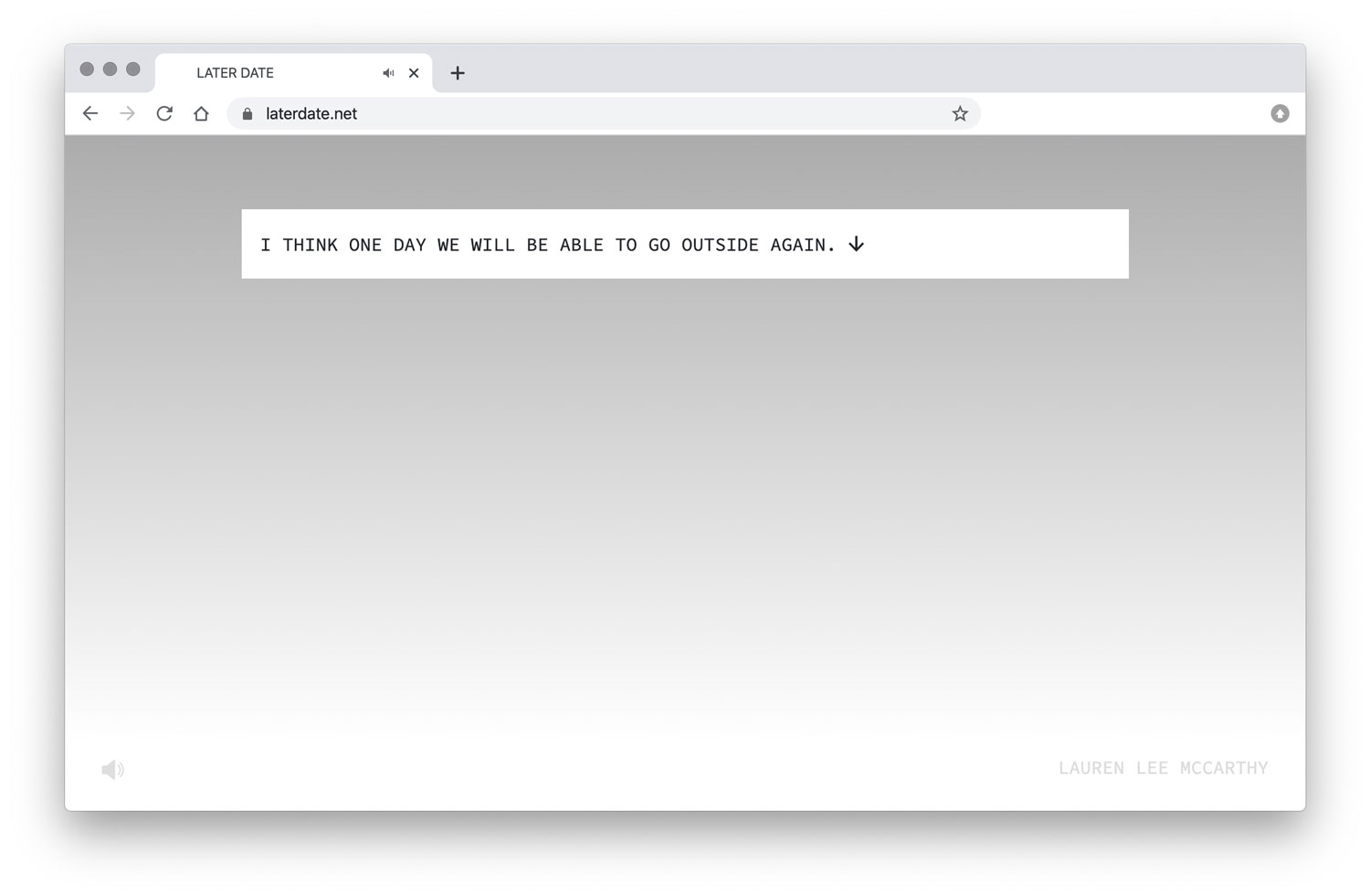
Screenshot of laterdate.net, background fades from gray to white, text reads, I think one day we will be able to go outside again.
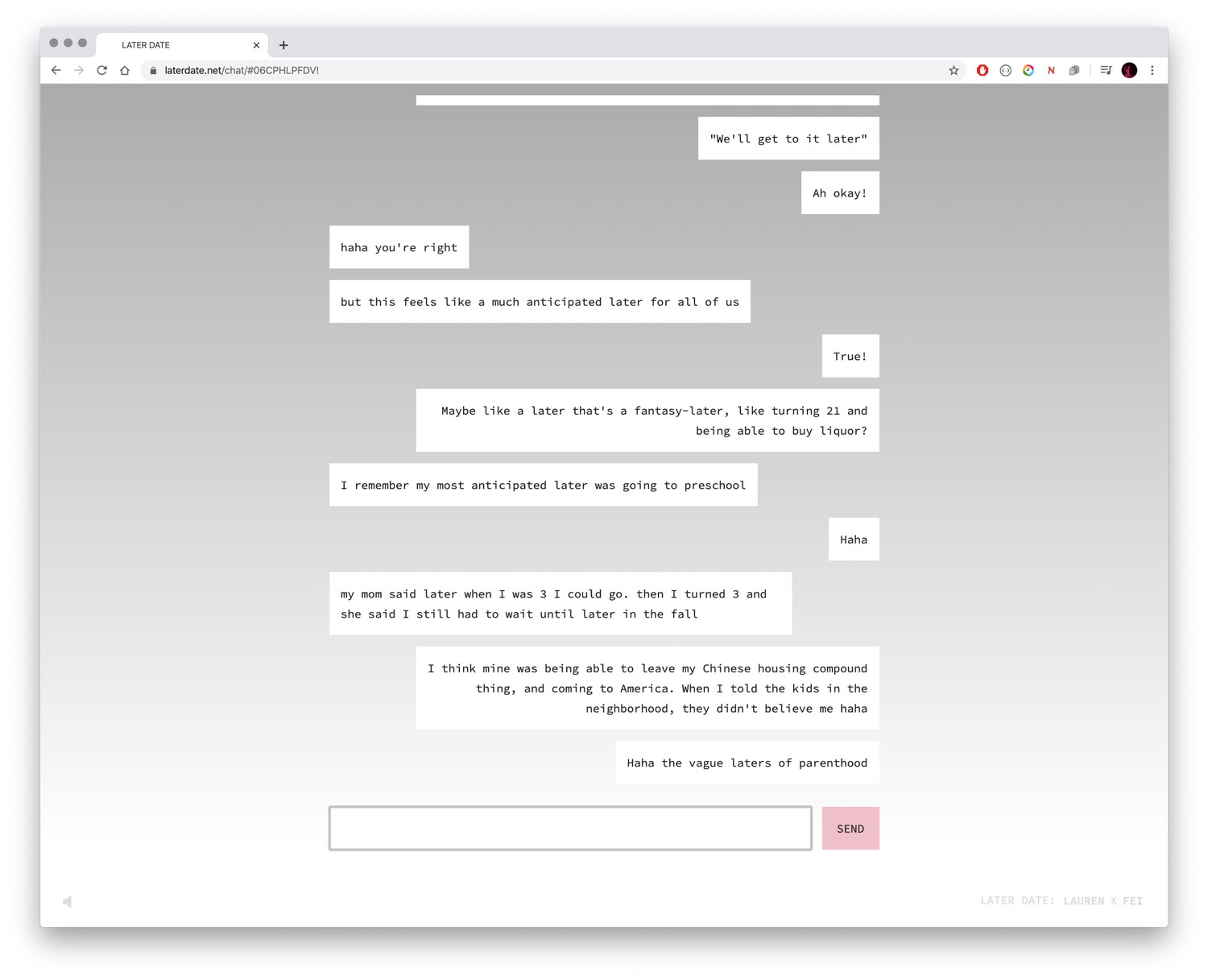
Screenshot of chat conversation about childhood “laters” playing out in real-time.
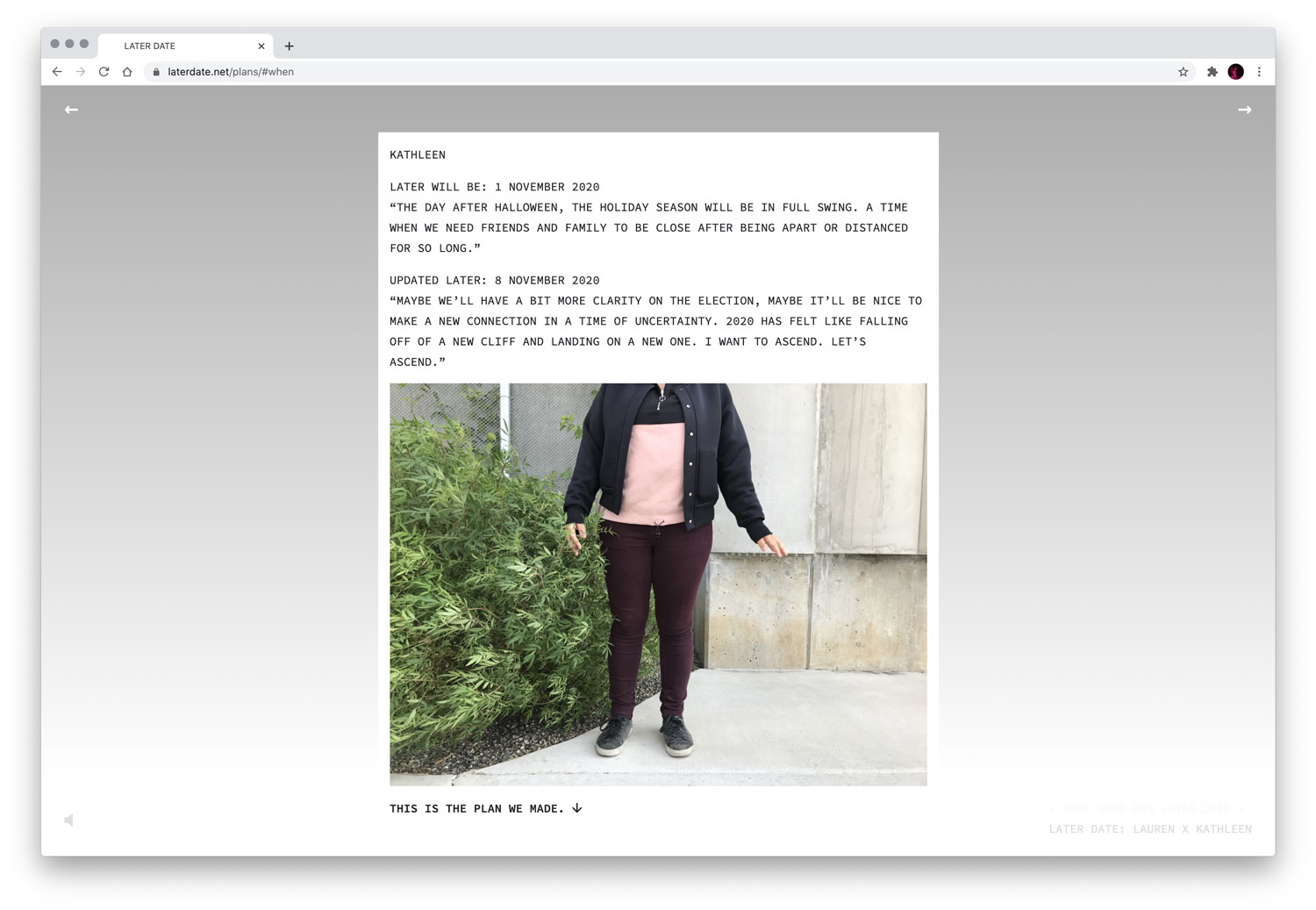
Later Date, 2020, https://laterdate.net/
10 This was the first in a series of gestures over the pandemic year trying to deal with the profound isolation I felt, stuck behind screens, backgrounded by a pervasive fear, suspended in time. I think most of us were feeling it. With the murder of George Floyd, that anxiety exploded into rage and grief that took over the streets, simultaneously bringing us together and pushing us further apart.
Our understanding of who is trustworthy, what is safe to do and talk about shifted. While the medical advice continued to evolve and update. Avoid surfaces. Check in with your friends. Don’t wear masks. Wear two. Don’t call, give them space. Keep six feet. Protest the right things. Don’t fly. Don’t talk politics. Restaurants are open, schools are unsafe.
They’ve recommended we stop talking to each other, they say talking is dangerous.
Feeling completely disconnected, I created I heard TALKING IS DANGEROUS trying to break through. Showing up on doorsteps, I deliver a monologue via phone screen and text-to-speech. I explain that I just heard masks and six feet are not safe enough. Because when you speak, tiny particles fly out through your mask at high velocity. They’ve recommended we stop talking to each other, they say talking is dangerous. So I made an alternative. I invite each person to visit a URL on their phone to continue the conversation. We proceed, discussing danger, safety, the future. Over the months we have learned to say things via text that perhaps we couldn’t in a more embodied way. Could this form of typing-speaking open anything for us?
next...
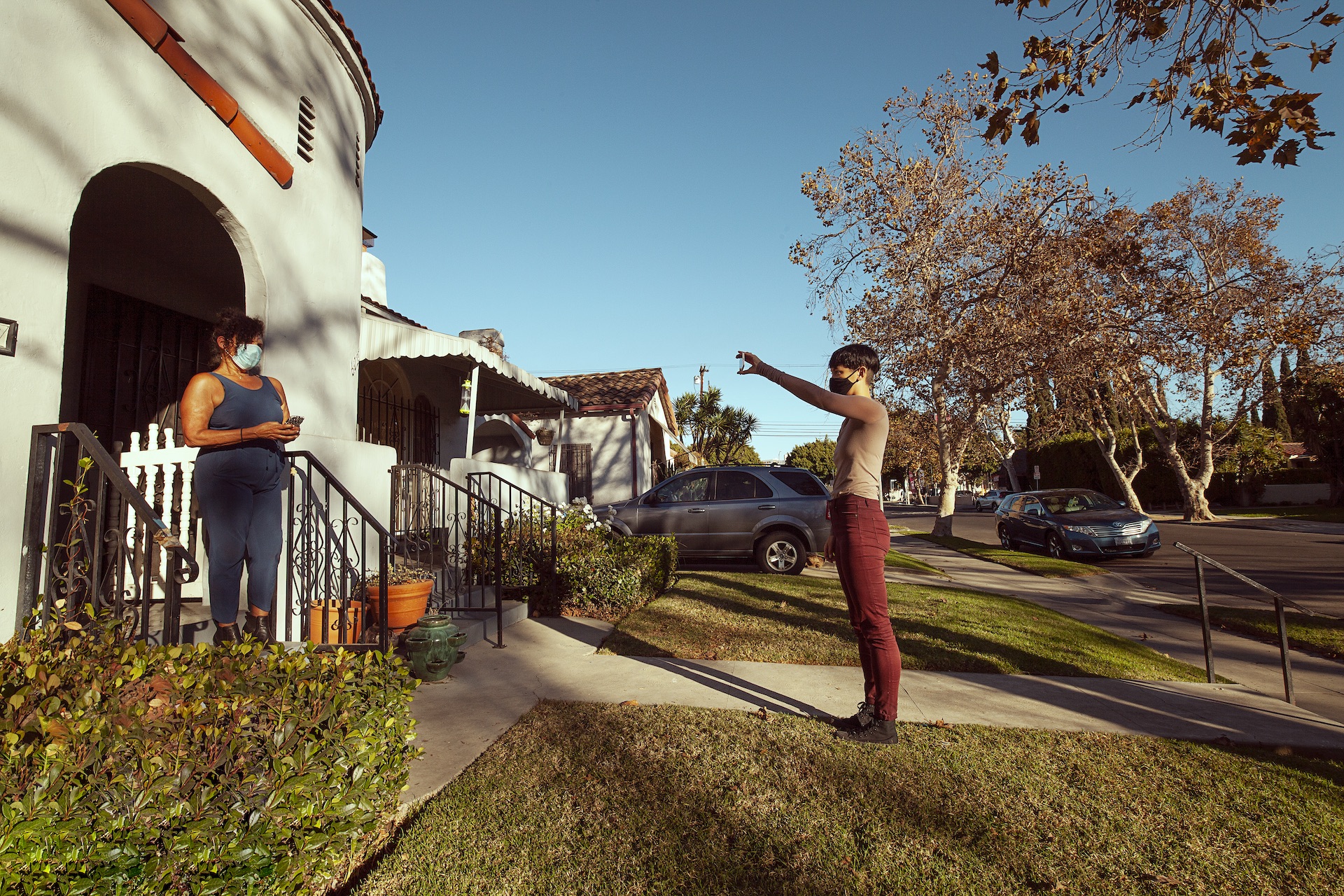
This image and the 4 images and vidéo following on the right: I heard TALKING IS DANGEROUS, Los Angeles, 2020, photo documentation by Kat Kaye, https://lauren-mccarthy.com/I-heard-TALKING-IS-DANGEROUS
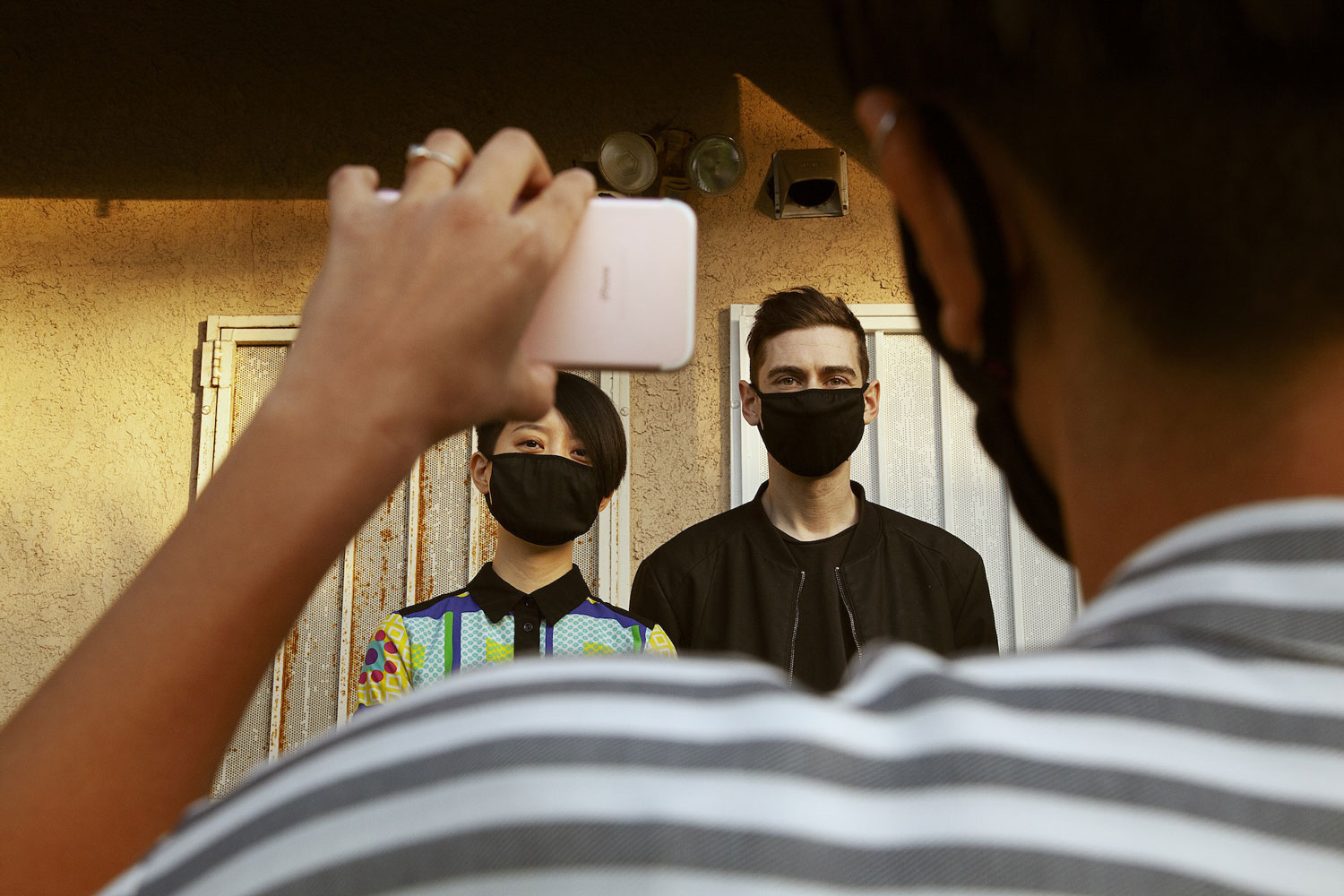
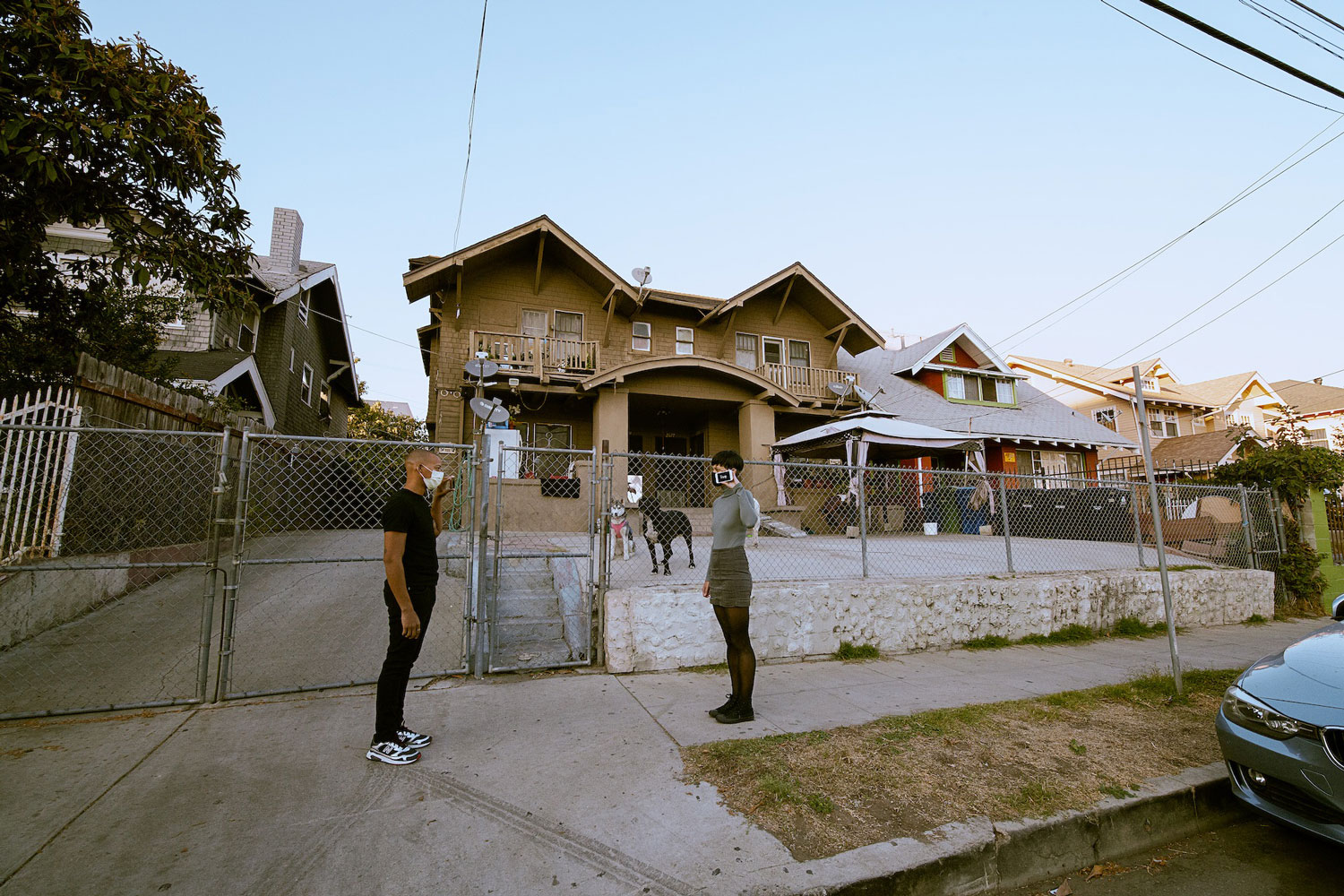
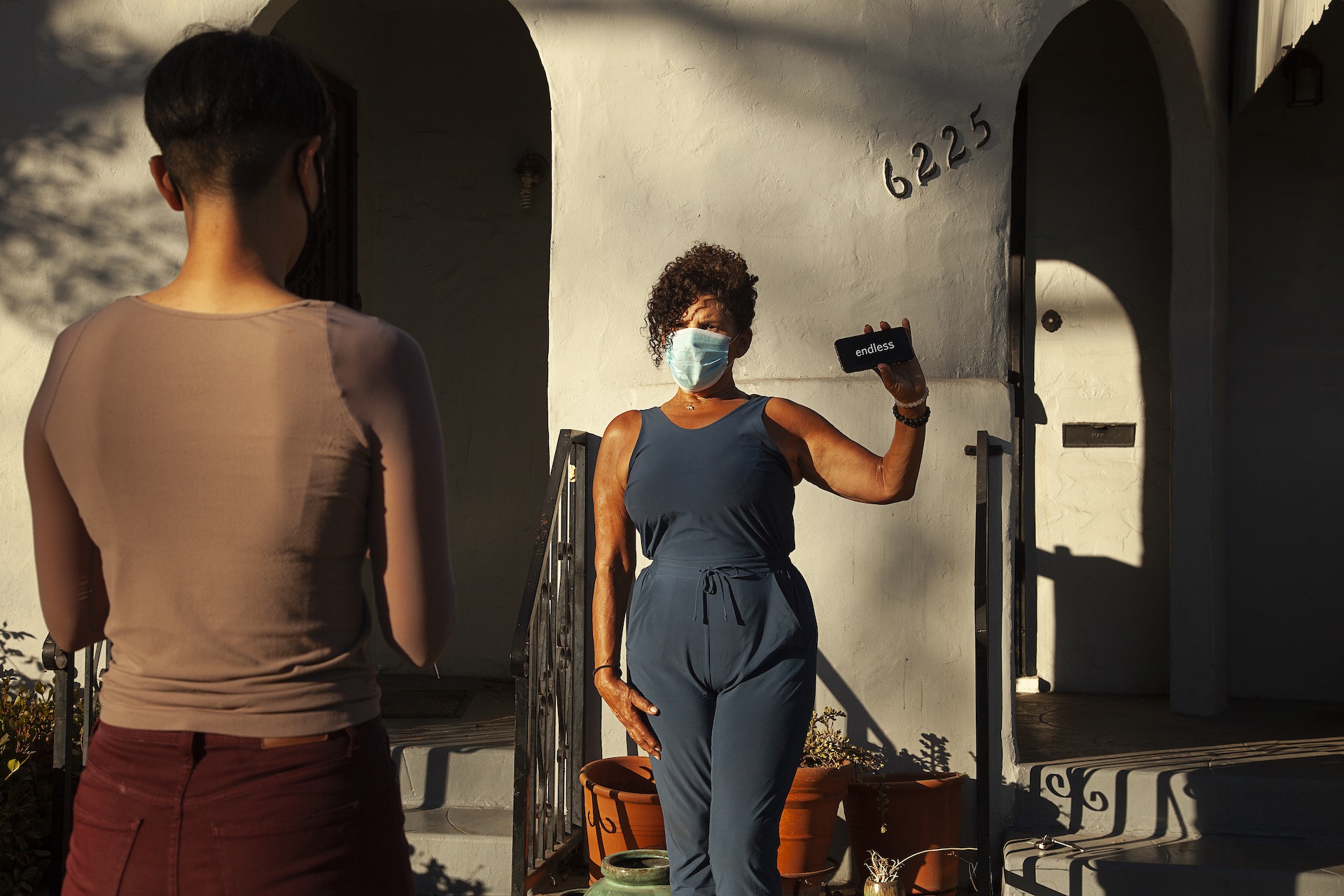
11 When I became exhausted with the constant Zoom calls, I created a digital clone of my voice to replace me. This voice allows me to puppet myself, using it to say all the things I hadn't previously been able to vocalize. I play with the phrases we expect from one another, and from machines. You can say turn off the lights. You can say wake me up at 7am. You can say talk to me. I am captivated by the ways we are taught to interact with algorithms, and how this shapes the way we interact with each other. What are the rules, what happens when we introduce glitches?
You can say turn off the lights. You can say wake me up at 7am. You can say talk to me.
I feel a sense of power owning the data of my own voice. I am taking it back from the tech companies, constantly tapping my conversations, sampling and analyzing and archiving my speech for future use yet unknown. Instead, I offer the control of my voice to others. Upon visiting my website, each visitor is asked by my voice, “What do you want me to say?” However they reply, my voice responds by speaking their own words back to them. Then it asks again, “What do you want me to say?”
next...
Lauren Lee McCarthy, You Can Say, 2021, audio excerpt #1, https://lauren-mccarthy.com/You-Can-Say
Lauren Lee McCarthy, You Can Say, 2021, audio excerpt #1, https://lauren-mccarthy.com/You-Can-Say
12 The further I got into this series of voice experiments, the more I began to dissociate. It became hard to tell what existed beyond my computer screen. Months of caution began to induce feelings of extreme recklessness and futility. In a last ditch effort to get close, I sent text messages to friends. A holiday offering of my live body outside their home. We have only text communication. I spend the night out on their lawn. Each of us thinking of the other’s physicality. Seeking presence.
In a last ditch effort to get close, I sent text messages to friends. A holiday offering of my live body outside their home.
I feel safety in this closeness at distance. While I’m thinking of all the others outside every night in more precarious positions. Last spring we witnessed extraordinary measures taken to provide housing and care, measures we were previously told were too hard and too expensive and would take too much time. As these safety nets are now being unravelled, how do we keep demanding support for the most vulnerable? Who are the people outside our homes that we choose to think of at night?
next...
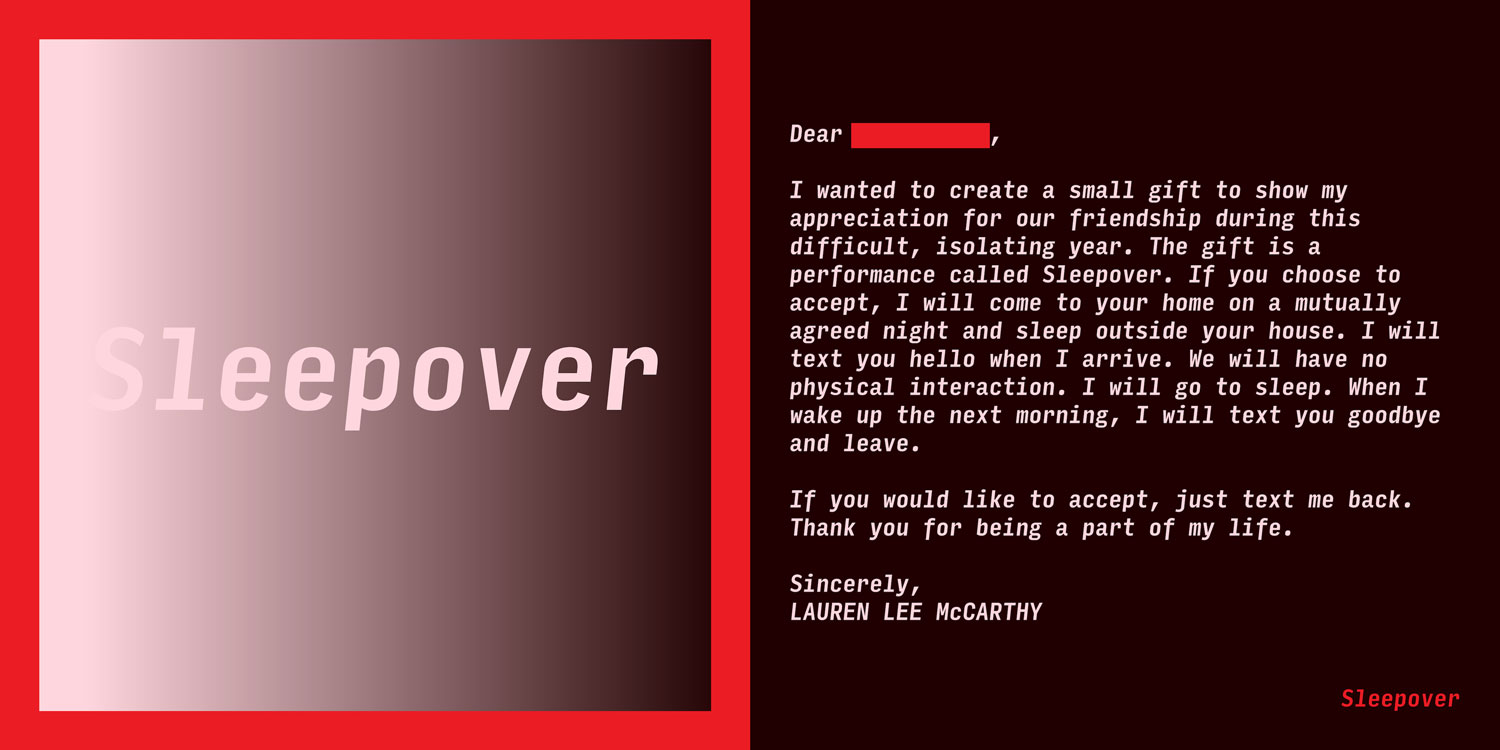
Sleepover, Los Angeles, 2020, photo documentation by David Leonard, https://lauren-mccarthy.com/Sleepover
Text: Dear _____, I wanted to create a small gift to show my appreciation for our friendship during this difficult, isolating year. The gift is a performance called Sleepover. If you choose to accept, I will come to your home on a mutually agreed night and sleep outside your house. I will text you hello when I arrive. We will have no physical interaction. I will go to sleep. When I wake up the next morning, I will text you goodbye and leave. If you would like to accept, just text me back. Thank you for being a part of my life. Sincerely, Lauren Lee McCarthy
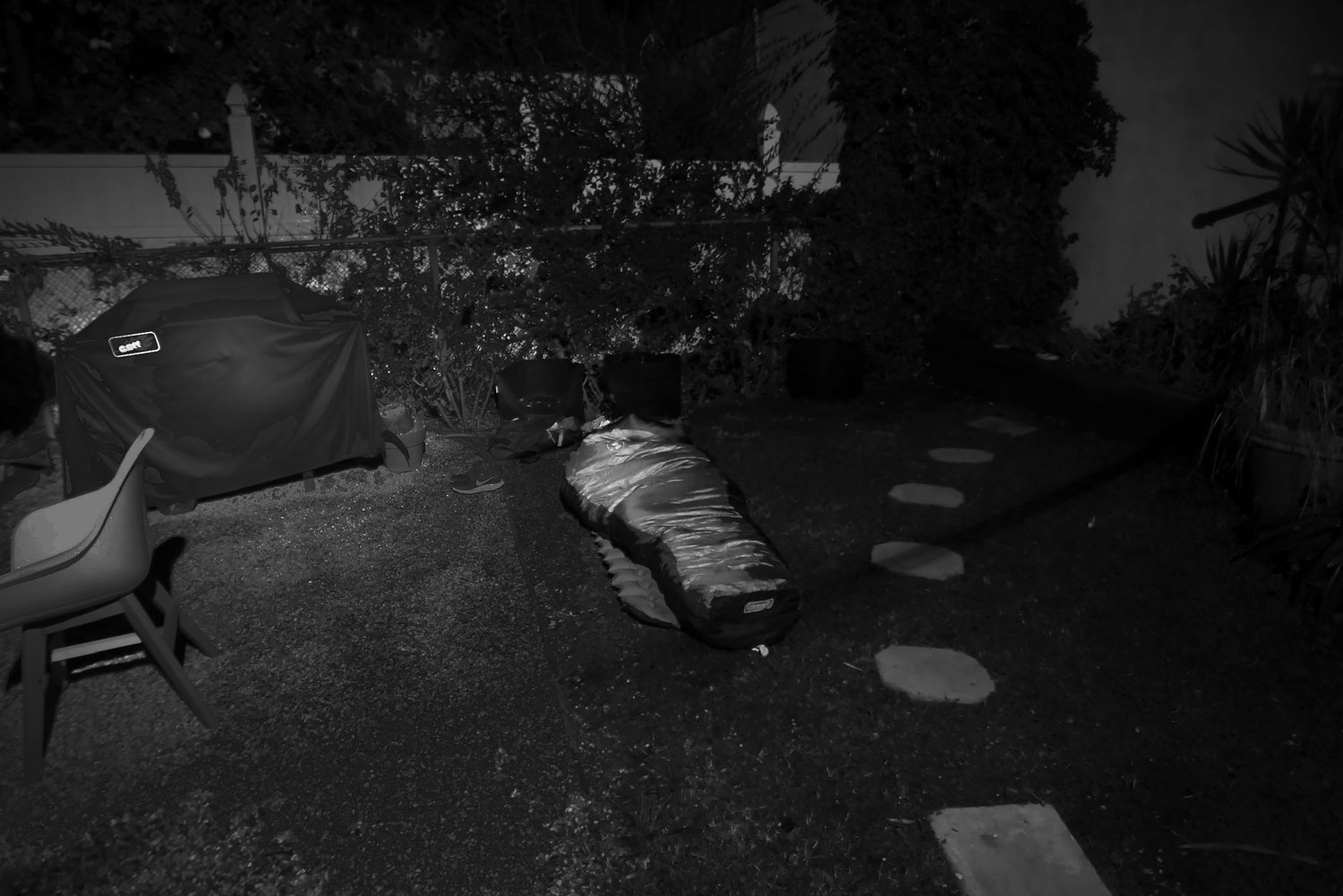
Sleepover, Los Angeles, 2020, photo documentation by David Leonard, https://lauren-mccarthy.com/Sleepover
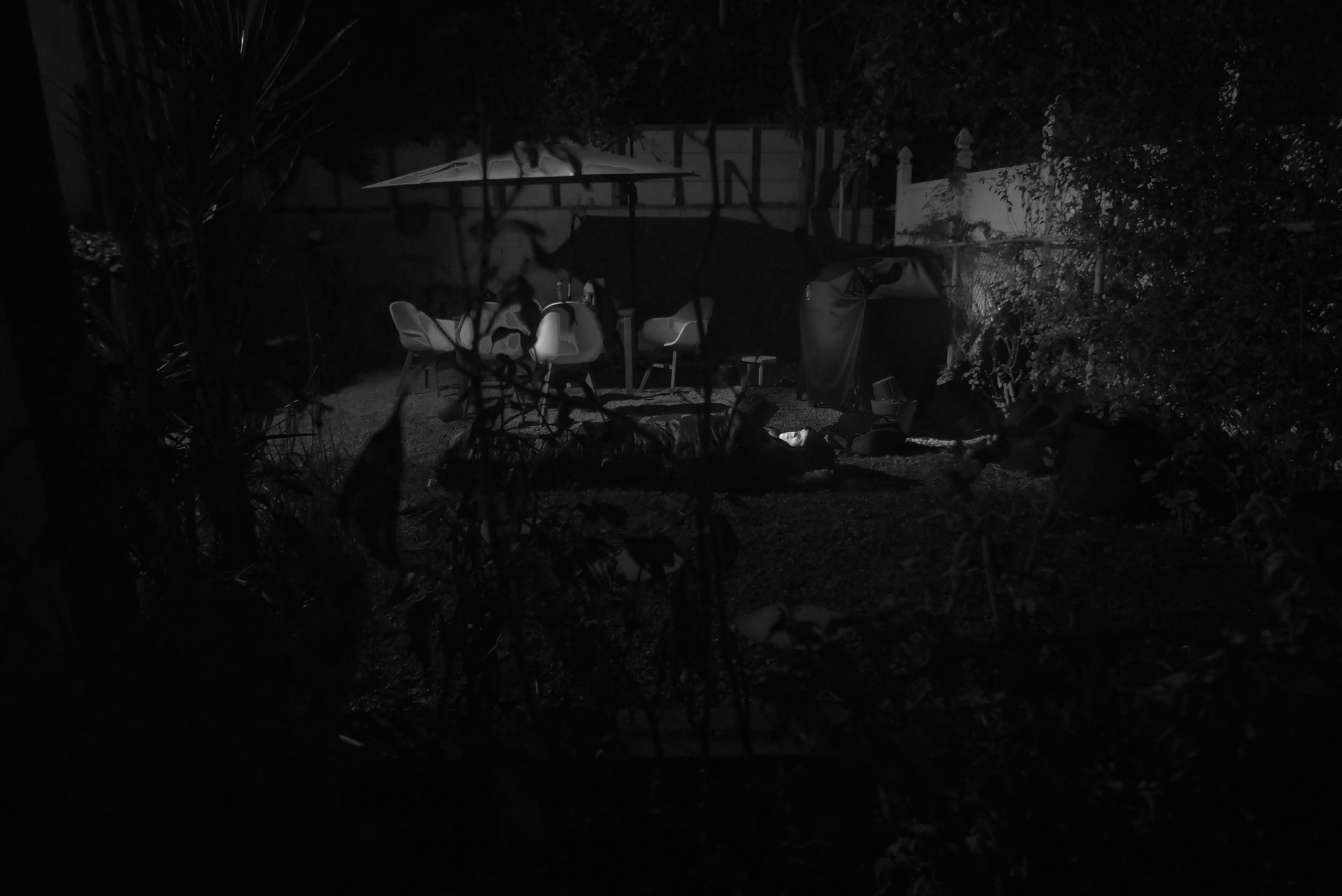
Sleepover, Los Angeles, 2020, photo documentation by David Leonard, https://lauren-mccarthy.com/Sleepover
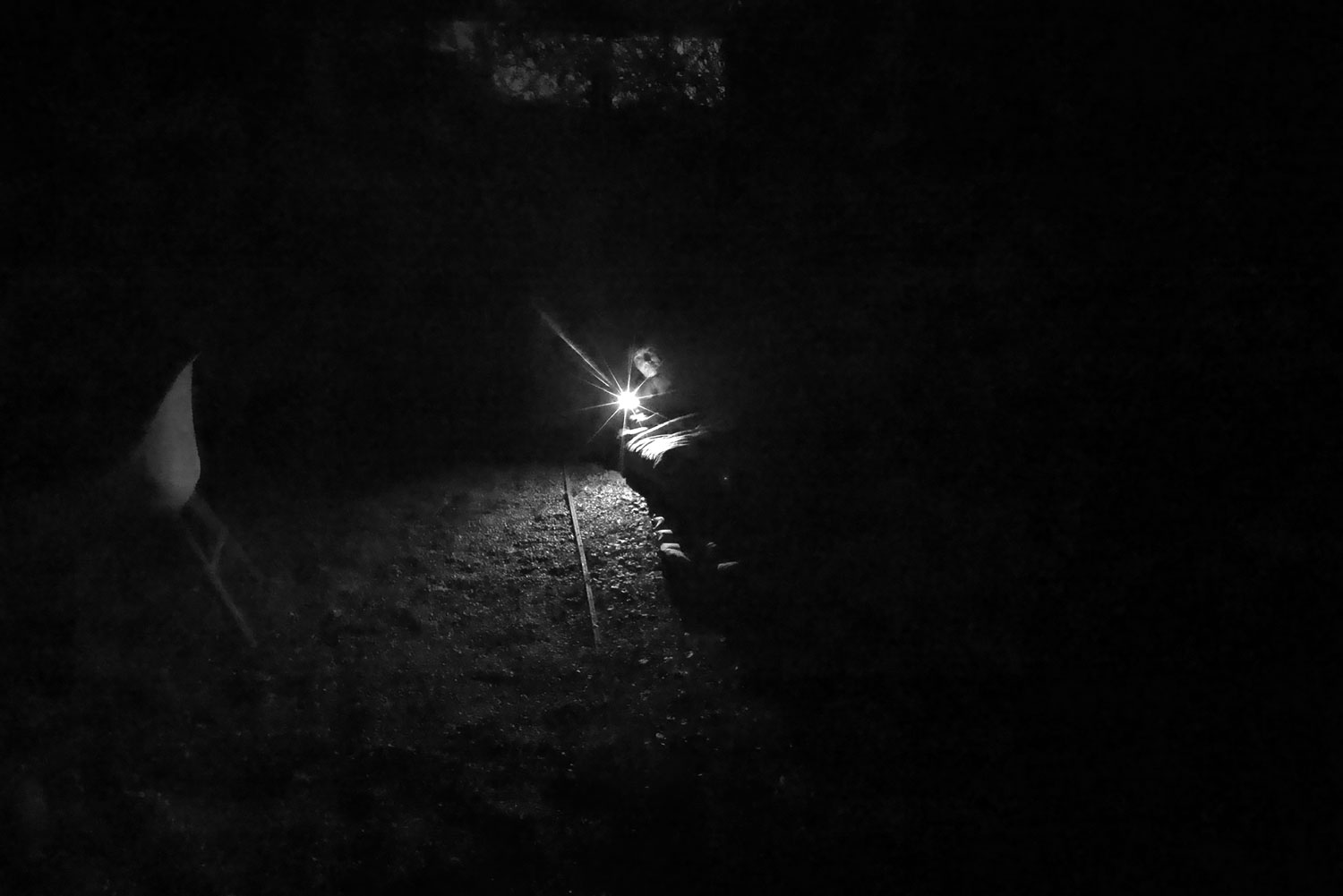
Sleepover, Los Angeles, 2020, photo documentation by David Leonard, https://lauren-mccarthy.com/Sleepover
13 After a year spent fearing for our health, grieving the loss of loved ones, watching the ever growing death counts, I have never felt so in touch with my own mortality. Drifting confused between utter stagnation and overwhelming transience, I started Good Night. A performance for one person that continues as long as I am alive. Every night before sleep, I text the owner of the work good night. At any point, that person may choose to pass the work to someone else, at which point the good night texts transfer to the next person. It is the first in a series of rest-of-life performances I plan to complete. What does it mean to commit, to something or someone, when the end is so palpable yet unknown?
What does it mean to commit, to something or someone, when the end is so palpable yet unknown?
This series of pandemic works, these protocols for presence, are about isolation, breakdown, danger, disconnection, grief, frustration, communication, wanting. Streaming ourselves through every possible channel, platform, and app, how do we hold each other together?
next...
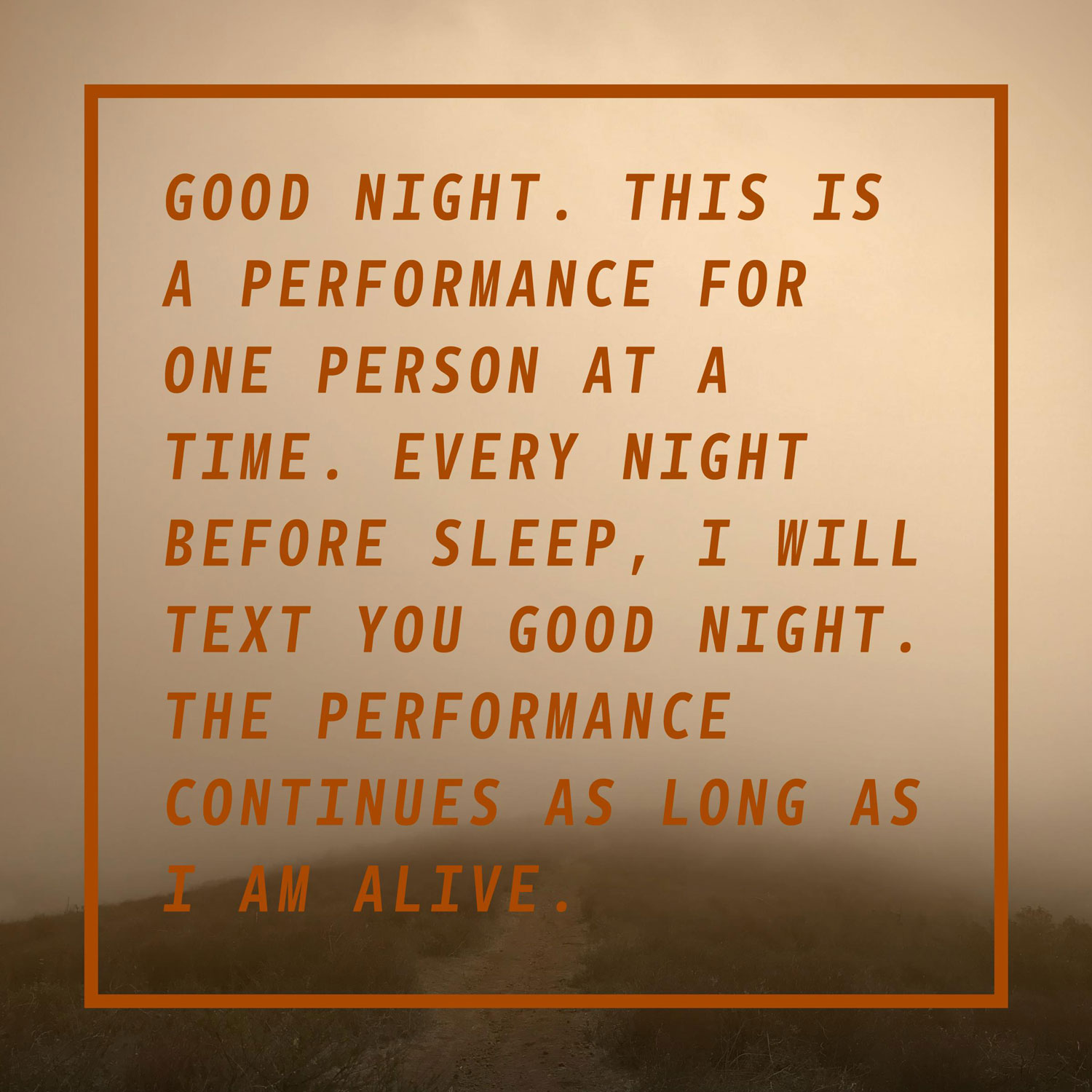
Good Night, 2021, http://lauren-mccarthy.com/Good-Night
14 A software system is a set of instructions, a code or a script. Is it reasonable to apply this same logic to social interaction? It helps me to understand the system and interface with others, but I worry about what I miss. If this, then that, loop repeat. But there is always a humanness in the interpretation of a social protocol, whereas a machine interpreter demands a precise series of directions or it fails. As technology moves ever closer to us, the scripts start to blend. I’m chasing the program crashes that open something up.
An attempt to hack my way out of myself and into closeness with others.
Each work I make feels like an attempt to hack my way out of myself and into closeness with others. I am embodying machines, borrowing their language. I am trying to understand that distance between the algorithm and myself, the distance between others and me. There’s humor in the breakdown, and also moments of clarity. Who writes the scripts for these artificial systems, what values do they embody? Who is prioritized and who is targeted as race, gender, disability, and class are programmatically encoded? Where are the boundaries around our intimate spaces? Perpetually in touch via networked interfaces, what does it mean to be truly present?
Return to the top of the article...


